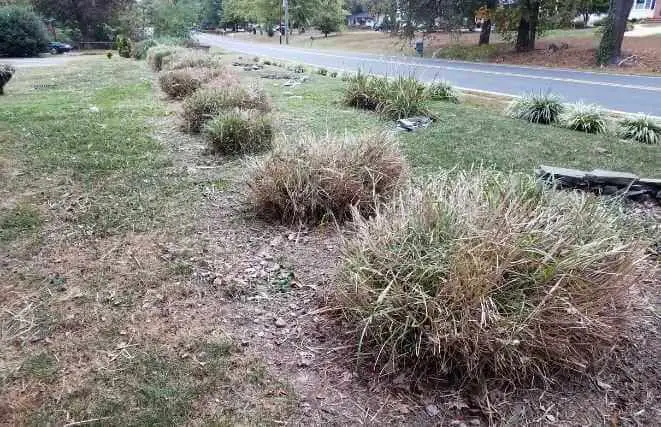Pampas grass (Cortaderia selloana) is a beautiful and popular ornamental grass known for its tall plumes and graceful appearance. To keep your pampas grass healthy and looking its best, proper pruning is essential.
The ideal height to cut back pampas grass depends on several factors, including the specific variety and its growth pattern. Generally, it is recommended to cut back pampas grass to a height of about 6 to 12 inches from the ground. This allows for new growth to emerge and maintain the plant’s overall health.
In this guide, we will explore the importance of pruning, the best time to prune, the tools you’ll need, and step-by-step instructions on how far to cut back your pampas grass.
Understanding the Pruning Process
When pruning pampas grass, it’s important to understand the process. Assessing the plant involves observing its condition and growth pattern, identifying dead or damaged foliage, and evaluating its overall size and shape.
Timing
Pruning pampas grass is typically done in late winter or early spring before new growth emerges. This timing allows for a fresh start and encourages healthy regrowth during the growing season.
Tools
To successfully prune pampas grass, you’ll need a few key tools, including sturdy gloves, long-handled pruning shears, loppers, and a pruning saw. These tools will enable you to handle the task safely and effectively.
| Tools | Description | Availability on Amazon |
|---|---|---|
| Pruning Shears | Handheld cutting tools with sharp blades for precise cuts | gonicc 8″ Professional Premium Titanium Bypass Pruning Shears |
| Loppers | Long-handled pruners with thick blades for larger stems | Fiskars 28″ Steel Blade Garden Bypass Lopper |
| Pruning Saw | A serrated saw for cutting thicker grass or woody stems | Pruning Saw Designed for Single-Hand Use |
| Gloves | Protective gloves to safeguard hands from sharp blades | Garden Gloves with Touch Screen |
| Safety Goggles | Eye protection against debris and grass particles | DEWALT DPG82-11C Concealer Clear Anti-Fog Dual Mold Safety Goggle |
| Gardening Apron | Apron with pockets to hold small tools and debris | Esschert Design unisex adult gardening aprons |
| Yard Waste Bags | Heavy-duty bags for collecting and disposing of cuttings | Reli. 39 Gallon Trash Bags Drawstring |
| Garden Pruning Tarp | Tarpaulin sheet for collecting cuttings and easy cleanup | Pruning Tarp with Hole |
| Handheld Broom/Rake | To clean up the area after trimming | Walensee Garden Leaf Rake 64 Inch |
Safety Precautions
Before you begin pruning, it’s important to wear protective clothing such as long sleeves, pants, and safety goggles to shield yourself from potential scratches or eye injuries. Additionally, consider using ear protection if using power tools for larger pruning jobs.
Assessing the Plant
Observing Plant Condition and Growth Pattern
Take a close look at your pampas grass to identify any dead or damaged foliage. Observe the growth pattern and assess whether the plant has become overgrown or lost its desired shape.
Identifying Dead or Damaged Foliage
Dead or damaged foliage can be identified by its brown color, lack of pliability, or absence of new growth. It’s essential to remove these blades during pruning to encourage healthy regrowth.
Evaluating Overall Plant Size and Shape
Consider the size and shape you desire for your pampas grass in your garden or landscape. Evaluate whether it has grown too large or needs to be rejuvenated. This assessment will help you determine the cutting height during pruning.

Determining the Cutting Height
Factors to Consider
When deciding how far to cut back pampas grass, consider factors such as your climate, desired appearance, and the overall health of the plant. Different regions and climates may require specific pruning approaches.
Recommended Cutting Heights
The cutting height for pampas grass can vary depending on the variety. Generally, a cutting height of around 6 to 12 inches from the ground is recommended. However, it’s important to note that cutting back pampas grass too severely can weaken the plant and make it susceptible to damage or disease.
Tailoring Cutting Height
Adapt the cutting height of your pampas grass to suit your garden or landscape requirements. You may choose a higher cut for privacy screening or a lower cut for a more manicured appearance. Flexibility in cutting height allows you to personalize the look of your pampas grass.
Step-by-Step Pruning Process
Preparation
Begin by clearing the area around the pampas grass to ensure easy access. Remove any obstacles or debris that might interfere with the pruning process. Gather all the necessary tools mentioned earlier to have them within reach.
Cutting Back Foliage
Using your long-handled pruning shears or loppers, carefully remove the dead or damaged blades of pampas grass. Cut these blades close to the base, taking care not to damage healthy growth.
Reducing Plant Height
To reduce the plant height, work in sections. Starting from the top, use loppers or a pruning saw to cut the grass to the desired height. Make clean cuts, ensuring they are level and not angled.
Cleaning Up
Collect the cut pampas grass blades and dispose of them appropriately. Place them in yard waste bags or compost them if suitable. Clean up the area around the pampas grass, removing any stray cuttings, to maintain a neat and tidy garden space.
Aftercare and Maintenance
Aftercare and Maintenance
Providing Necessary Post-Pruning Care After pruning, give your pampas grass some post-pruning care. Water the plant thoroughly to help it recover from the pruning process. Consider applying a balanced fertilizer to promote healthy regrowth.
Fertilizing and Watering Considerations
Regularly fertilize your pampas grass during the growing season using a slow-release or balanced fertilizer. Ensure it receives adequate water, particularly during dry periods, to keep it healthy and thriving.
Monitoring Plant Health and Regrowth
Keep a close eye on your pampas grass after pruning to monitor its health and regrowth. Look for signs of new growth and assess whether further pruning may be needed to maintain the desired size and shape.
Best electric tool to cut down large pampas grass
BLACK+DECKER 3.2AMP 17-inch Electric Hedge Trimmer BEHT150
A Powerful and Efficient Trimming Companion: BLACK+DECKER Electric Hedge Trimmer (BEHT150) Review
Introduction
The BLACK+DECKER Electric Hedge Trimmer, with its 17-inch blade and impressive features, has become my go-to tool for maintaining my hedges and shrubs. In this review, I’ll share my experience with this powerful trimmer and highlight its standout qualities.

Check the latest price on Amazon
Performance and Power
Equipped with a robust 3.2-amp motor, the BEHT150 delivers exceptional cutting performance. The 17-inch dual-action hardened steel blade effortlessly glides through branches, providing clean and precise cuts. I was impressed by its power, allowing me to tackle even thicker branches with ease. The trimmer’s cutting capacity of up to 5/8 inches is suitable for most residential hedge trimming needs.
User-Friendly Design
One of the standout features of the BEHT150 is its user-friendly design. The lightweight construction and well-balanced design ensure comfortable handling, reducing fatigue during extended trimming sessions. The two-handed operation with a comfortable grip provides excellent control and maneuverability.
Safety Features
Safety is a top priority, and the BLACK+DECKER Electric Hedge Trimmer doesn’t disappoint. The built-in cord retention feature prevents accidental unplugging during operation, ensuring uninterrupted trimming. Additionally, the trimmer has a lock-off switch that prevents accidental startup, adding an extra layer of safety.
Convenience and Versatility
This electric trimmer offers the convenience of corded operation, eliminating the need for battery charging or refueling. With a generous 17-inch blade length, it covers a wide cutting swath, reducing the number of passes required to trim hedges. The trimmer’s lightweight design makes it easy to transport and store.
Overall Impressions
The BLACK+DECKER Electric Hedge Trimmer (BEHT150) is a reliable and efficient tool for all your hedge trimming needs. Its powerful motor, sharp blades, user-friendly design, and safety features make it a standout choice among electric trimmers. Whether you’re a professional landscaper or a homeowner looking to maintain your hedges, this trimmer delivers outstanding performance. I highly recommend the BEHT150 for its reliability, ease of use, and excellent value for the price.
Note: This review is based on personal experience and may vary depending on individual preferences and usage conditions.
Learn more about Pampas grass
Pampas grass, scientifically known as Cortaderia selloana, is a tall, perennial grass native to South America, particularly the Pampas region. It has gained popularity as an tall ornamental grass for privacy in gardens and landscapes around the world due to its striking appearance and versatility. Here are some key points to learn more about Pampas grass:
- Appearance: Pampas grass is characterized by its large, feathery plumes that can reach impressive heights of up to 10 feet or more. The plumes come in various colors, including creamy white, pink, and mauve, adding a touch of elegance to any setting. The grass itself features long, arching blades that create a graceful and dramatic effect.
- Growth Habit: Pampas grass is known for its vigorous growth and resilience. It forms dense clumps that can expand over time, making it suitable for creating privacy screens, borders, or focal points in the landscape. However, its rapid growth also requires regular maintenance, including pruning and division to prevent overcrowding.
- Growing Conditions: Pampas grass thrives in full sun and well-draining soil. It is adaptable to various soil types, including sandy or clay soils, but requires regular watering during its establishment phase. Once established, it is relatively drought-tolerant and can withstand harsh weather conditions.
- Care and Maintenance: Proper care is essential for the health and longevity of Pampas grass. Regular pruning is necessary to remove dead or damaged foliage and to control its size. Division every few years helps rejuvenate the plant and prevent overcrowding. Additionally, removing spent plumes in late winter or early spring promotes new growth and maintains the plant’s aesthetic appeal.
- Considerations: It’s important to note that Pampas grass is considered an invasive species in some regions, including parts of the United States. Before planting, check with local authorities or garden centers to ensure it is not listed as an invasive species in your area.
Pampas grass is a captivating addition to any garden or landscape, providing texture, movement, and visual interest. By understanding its characteristics and care requirements, you can enjoy the beauty and charm that this ornamental grass brings to outdoor spaces.
MORE: How to Grow Pampas Grass
FAQ
When it comes to cutting pampas grass, it is generally recommended to cut it back to a height of around 6 to 12 inches from the ground. However, the specific cutting height can vary depending on factors such as the pampas grass variety, desired appearance, and climate. It’s important to consider the overall health and size of the plant when determining the cutting length. Additionally, tailoring the cutting height to specific garden or landscape requirements allows for personalization. By following proper pruning techniques and considering these factors, you can maintain the health and aesthetic appeal of your pampas grass.
Yes, it is possible to cut yourself on pampas grass. The grass blades of pampas grass are sharp and can cause injuries if not handled carefully. When pruning or working around pampas grass, it is important to wear sturdy gloves and protective clothing to minimize the risk of scratches or cuts. Additionally, it is advisable to exercise caution and use proper tools, such as long-handled pruning shears or loppers, to safely handle the plant. Taking these precautions will help reduce the chances of getting cut while working with pampas grass.
Conclusion
Pruning pampas grass is an essential task for its overall health and aesthetic appeal. By following the correct pruning techniques and considering factors such as cutting height and timing, you can ensure your pampas grass thrives in your garden or landscape. Remember to always wear protective gear, use the right tools, and take proper aftercare measures to support the plant’s growth. Enjoy the beauty and vitality of your well-pruned pampas grass throughout the seasons!








